- Colection of 65 PHP scripts for $4.29 each
Pitting PHP vs JavaScript is not easy. There are many ways to compare the two programming languages. In this post we will introduce them to you in detail to give you a better understanding of both languages. We’ll talk about their similarities and differences, pros and cons, and which of them it makes more sense to learn (or learn first).
What is the Difference Between PHP and JavaScript?
Before diving deeper, let’s give a short introduction of the two programming languages and talk about what they have in common and what makes them different from each other.
The Similarities
Part of the reason why the PHP vs JavaScript discussion exists in the first place is because, on some level, the two are not so different after all. Here’s what they have in common:
- Scripting languages – Both PHP and JavaScript are scripting languages, which means they do specific tasks within an existing environment. They are also interpreted rather than compiled, meaning they are translated into machine-readable code while being processed – instead of beforehand. This makes their runtime slower than compiled languages but it also makes them easier to use – you can simply modify the code and see the effects immediately.
- Weakly typed – In both PHP and JavaScript, you can define variables without assigning their data type. Both languages will figure it out from the variables’ content. In other languages, you have to specifically name the data type.
- Object-oriented – The two languages can both create objects or classes. These are pieces of data with unique attributes and behavior. Object-oriented programming languages focus more on the elements that programmers want to manipulate rather than the logic behind the manipulation. However, this kind of ability is a later addition to both contenders, 2005 for PHP and even 2015 in the case of JavaScript.
- Cross-platform – This means they work in different environments and platforms, e.g. Windows, MacOS, Linux, Android, iOS, and different browsers.
- Similar syntax – There are also some syntactic similarities between both languages and they work with very similar concepts such as variables, arrays, for loops, and more. If you know these types of fundamental principles from one language, it’s easier to use them in another. You just need to learn the new syntax.
Alright, now that we know what makes PHP and JavaScript similar to each other, let’s talk about each language in more detail and see what sets them apart.
What is PHP?
PHP stands for “Hypertext Preprocessor”. If you’re confused that this acronym doesn’t line up with its name, know that PHP originally comes from “Personal Home Page Tools”. This is what PHP developer Rasmus Lerdorf called a bunch of scripts he used on his own website already back in 1994. A few years later, a completely rewritten version of the language was launched and the acronym got the new meaning.
The programming language is very popular. Famous users include Facebook, Lyft, Wikipedia, Slack, and Tumblr. While you can use it for software development, it’s probably most popular as the basis of content management systems (CMSs) like WordPress, Joomla, and Drupal. Here it creates HTML output by pulling data from a database and embedding it in dynamically created pages.
That’s also what PHP is most known and used for. Yet, it has other capabilities, such as evaluating form data, sending and receiving cookies, and a lot more. For a more detailed overview of some of the functionality, check our PHP cheat sheet.
However, the most important thing about PHP is where it is executed. It’s a server-side scripting language, which means it’s being processed on the server that houses the files. The browser only receives the result to display without ever having access to the underlying PHP code. Because of that, PHP is also regarded exclusively as a back-end language.
What is JavaScript?
JavaScript was created in 1995 by Brendan Eich who was working at Netscape at the time. Today, the language is based on ECMAScript, which is an open standard for creating scripting languages, put forth and maintained by ECMA. Because JavaScript adheres to ECMAScript very closely, some people use the names interchangeably.
In contrast to its competitor, people usually use JavaScript to add movement and dynamic animations to the front end of websites and applications. Its most common application is to manipulate the DOM (document object model), meaning the HTML structure of a web page. If you have ever clicked on a collapsible page element like an FAQ item, you have seen it in action. Examples for famous applications running on JavaScript are Netflix, Trello, Uber, Airbnb, Instagram, and Medium.
The biggest difference with PHP is that JavaScript is originally a client-side language, meaning it executes in the user browser. Since it doesn’t need connection to a server to work, it means it lets you make changes on a web page without having to reload it.
However, with the Node.js framework, it is now also possible to have server-side execution of JavaScript and use it across the full stack. This means just like PHP, you can use JavaScript to produce content on the server and send it to the browser. This makes it suitable for building entire web applications from beginning to end.
PHP vs JavaScript: Speed Comparison
Because the main difference between PHP and JavaScript is that one of them runs server-side and the other is a client-side scripting language, there are often big differences in speed.
A JavaScript application can show and implement changes immediately, while PHP needs to send a request to the server first and wait for the answer as well as often reload the page to make the change visible. Even on a server, as in the case of Node.js, JavaScript is usually faster.
JavaScript is also asynchronous and single-threaded, which means, while it can only carry out a single task at a time, tasks start executing without waiting for their predecessors to finish. In contrast, PHP is synchronous and multi-threaded. So, while it can execute code in different threads, it has to wait for previous jobs to finish before continuing.
All of the above makes JavaScript faster in most cases.
What Can You Build With Either Language?
Another difference between PHP and JavaScript is what you can build with each of them. Though they have similar capabilities, they are usually employed in very different ways.
PHP, though flexible, is primarily used to create dynamic web pages. It’s great for building blogs, ecommerce sites, and forums but also WordPress themes and plugins. You can also use it for user authentication, cookie authentication, session handling, and to build a server back end. Finally, it’s also suitable for software like instant messaging and other real-time applications.
In web design JavaScript often powers drop-down menus, forms, popups, interactive maps, animations and other interactive elements. However, it’s also suitable for large projects and can power both the front end and back end of single-page apps (SPA), native mobile apps, and desktop applications. In addition, it can run smart TVs, Internet-of-Things devices, and even be used for artificial intelligence and machine learning.
It’s also possible to use both languages together. A common example in web development is web forms, where JavaScript might validate the user input on the front end before saving it to a database via PHP.
Which is Better, PHP or JavaScript?
With the above in mind, which is the better programming language? In order to find out what speaks for and against each, let’s go over some pros and cons.
Pros and Cons of PHP
Let’s start off with PHP and its advantages:
- Easy to learn – The programming language has lots of existing functions, an easy syntax, and is quite beginner and user-friendly.
- Popular – There already is a lot of PHP-based software that makes web development cheaper and easier. See the aforementioned WordPress, which runs 40+% of the Internet. With PHP skills you can hit the ground running and start building websites immediately.
- Database access – PHP runs on the LAMP (Linux, Apache, MySQL, PHP) stack, which means it works well with MySQL, MariaDB, PostgreSQL, Oracle, and other database formats. This is great for working with loads of information, such as for an online store.
- Open source – There is a large community around PHP. It’s flexible and customizable, works on almost every operating system, browser, and server, and is also free.
- Security – Since PHP is not visible in the browser, it’s much harder to hack. It can also do cookie and session handling, authenticate usernames and passwords, do two-factor authentication, and has built-in features for data sanitization.
However, PHP also has its downsides:
- Back end only – In terms of web development PHP has a single role: running the back end. It’s not a front-end language, so that’s all there is.
- Limited – You can combine it only with HTML. If you want to create an app with PHP, you need to know four different syntax systems (all of LAMP) plus HTML and CSS.
- Needs a runtime environment – In order to use PHP, you need a (virtual) web server.
- Slower – As already mentioned, its dependency on communicating with the server makes PHP slower than its counterpart.
Pros and Cons of JavaScript
Now let’s look at the pros and cons of JavaScript. Here are the upsides:
- Easy to get started – For JavaScript, all you need is a browser like Chrome and you can start typing away in the console, there’s no need for a development environment. It also has a simple syntax even if it’s not as simple as PHP.
- Full stack capabilities – You can develop entire web and mobile applications with JavaScript, from front to back.
- Powerful and versatile – As mentioned above, JavaScript’s capabilities go way beyond web development.
- Extendable – You can combine it with HTML, XML, and Ajax. Plus, there are lots of frameworks that make development faster and easier.
- Faster – Fewer server requests and less load and traffic on the server increase performance.
Here’s what’s not so great about JavaScript:
- Not open source – JavaScript itself is not open source, only its frameworks are open standard. The programming language itself is maintained by W3C and ECMA. However, there’s a large community around JavaScript that constantly works on improving it.
- Less secure – When it runs in the client browser, JavaScript code can be compromised for malicious intent. Tools to increase security are available but it requires more effort to implement them.
- Limited database capabilities – JavaScript is starting to have the possibility to work with databases but is nowhere near what PHP can do at this point.
- SEO challenges – It’s unclear how well search engines can crawl JavaScript, which represents a potential SEO issue. You need to know how to implement it properly to avoid problems.
Should You Learn JavaScript or PHP First?
In the end, there are good points for and against learning either language. For that reason, when looking at PHP vs JavaScript, the big question is often which one you should start learning first. In this final section we’ll go over exactly that.
Which Language Is More Popular?
One way to look at whether to learn one or the other is to look at the popularity of the two programming languages. According to W3Techs, PHP runs on 78.4% of websites in contrast to only 1.7% of websites that use JavaScript.

However, you have to keep in mind that this looks at back-end technology which is a) PHP’s specialty and b) a capability that JavaScript hasn’t had for a very long time. Also there’s a trend visible that the more popular a website is, the higher the use of JavaScript as its back-end language.
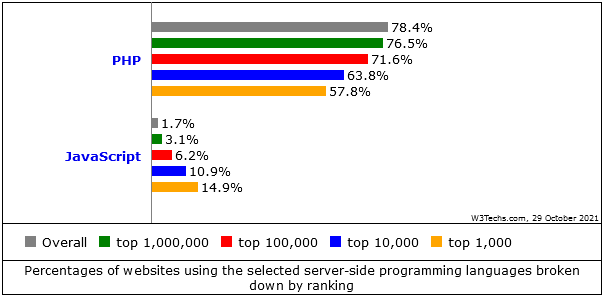
So it looks like the big players in the market are starting to shift JavaScript. In addition, it’s the client-side language on almost 98% of all websites.

What’s more, JS has been the most popular language in the Stack Overflow developer survey for nine years in a row.
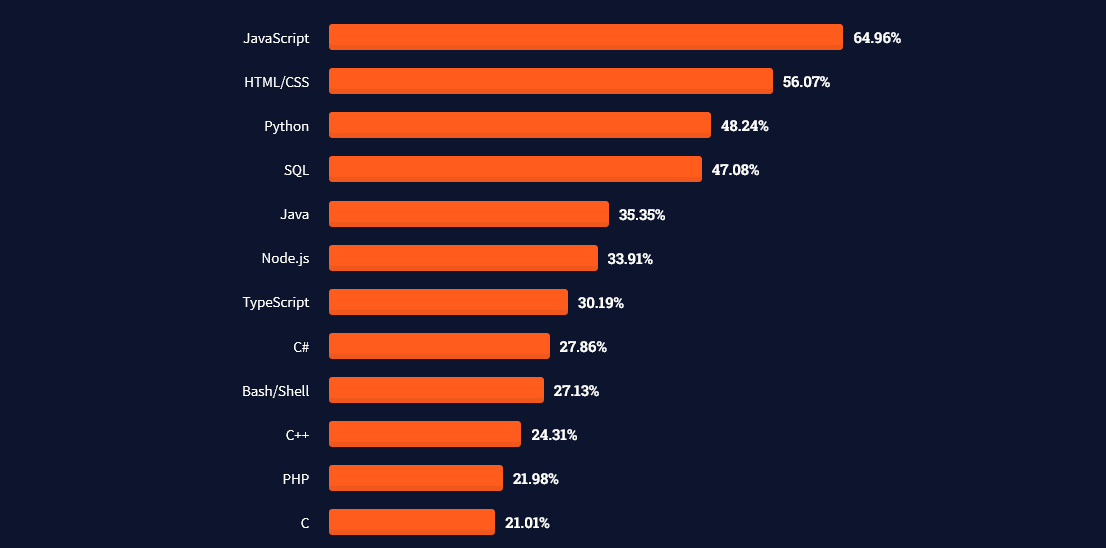
It’s also the language with the most pull requests on Github (18%) while PHP only scores eighth with roughly 5%.
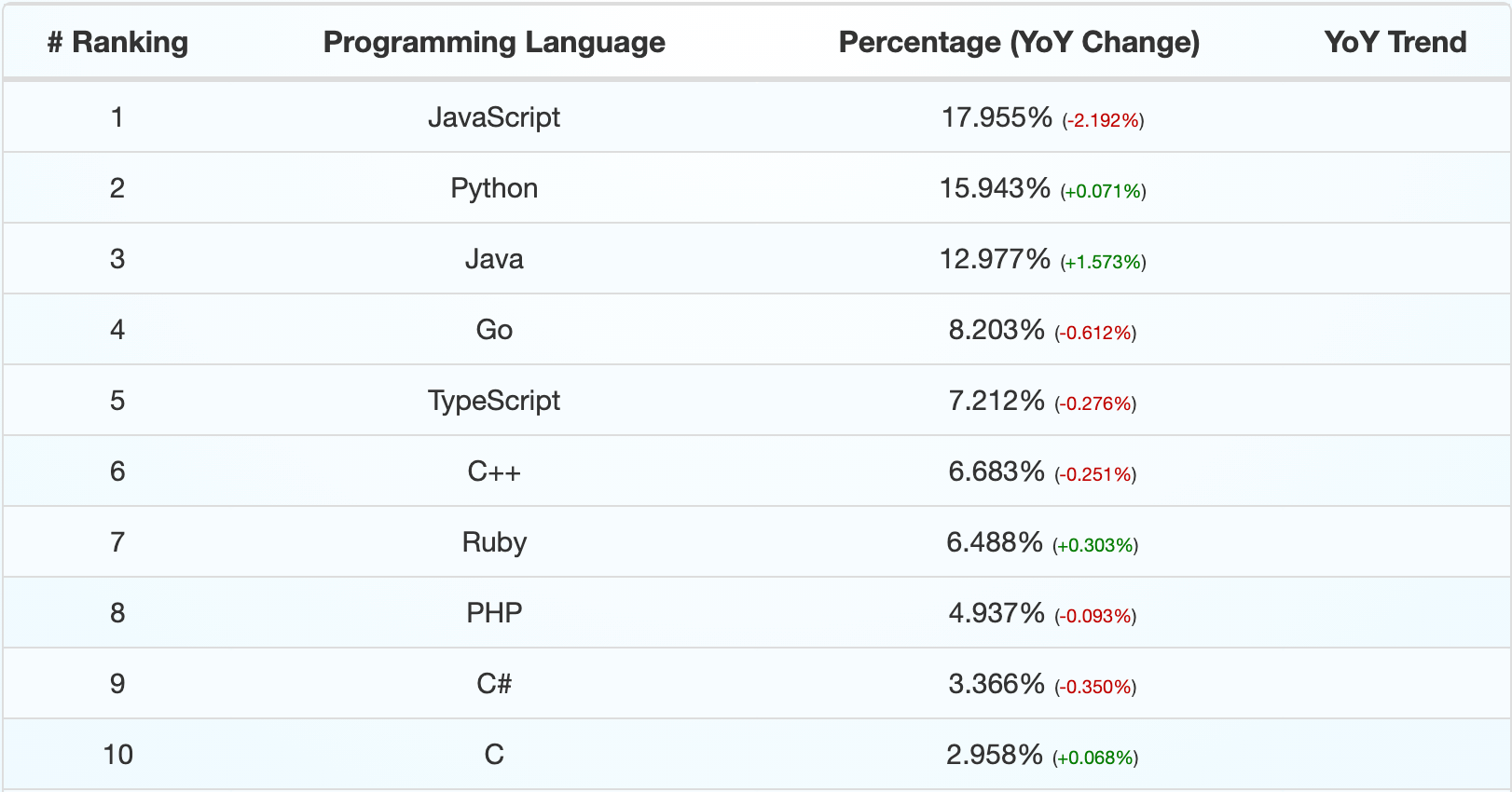
However, you have to keep in mind that PHP is also behind WordPress, Joomla, and Drupal, which together power almost half of the web. So, while JavaScript is the hot new thing on the block, PHP has a comfortable position as a very established technology.
Which Is Easier to Learn?
Another way to look at which language to choose is to see which is easier to pick up.
Here, PHP is pretty clearly ahead. It’s easy to get into, has loads of built-in functions that allow you to do stuff right away, and is overall better for beginners.
In contrast to that, the learning curve for JavaScript is much steeper because it’s more complex. On top of that, JavaScript can also be confusing because it has branched out into many frameworks such as Angular JS, React JS, Vue, jQuery, and Svelte.
Plus, it’s important to note that CSS is increasingly adding native functionality to do the things you used to need JavaScript for. So, if you only want to do things like sliders or accordions, you can simply improve your CSS skills, instead of having to learn JavaScript.
PHP vs JavaScript: Which Is Better for Your Career?
Finally, let’s look at the career opportunities each programming language offers.
According to Indeed.com the average base salary of a PHP developer in the United States is $92,231 per year. In contrast to that, for JavaScript developers it’s $110,271. Even beginners can expect to start at $90,000.
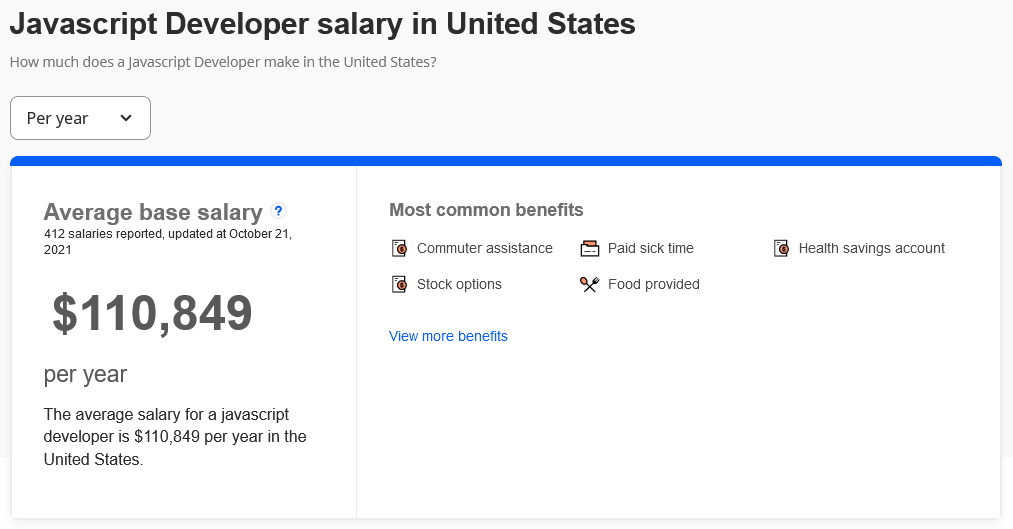
While Glassdoor gives lower estimates, it paints a similar picture. PHP developers earn $79,499 on average, going as low as $52,000 and as high as $121,000. On the other hand, the average JavaScript developer salary is around $90,000 with $54,000 as the low and $154,000 as the high.
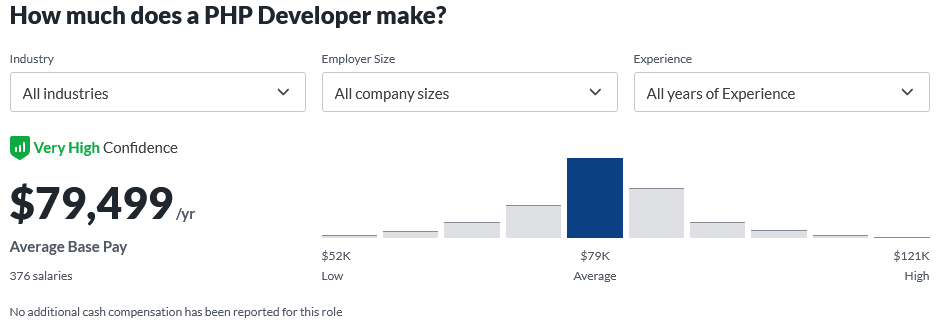
Plus when you search for JavaScript jobs on LinkedIn, it shows over 550,000 job openings in the United States alone. For PHP, the results are only around 51,000.

In short, when it comes to career prospects and earning potential it’s better to start learning JavaScript than PHP.
PHP vs JavaScript: Final Thoughts
PHP vs JavaScript is a debate that you can look at from many angles. Both languages have their strong suits and weaknesses, areas of applications they are most suitable for and those they are not. So, when should you choose what?
Roughly, pick PHP if you plan to develop a blog or an ecommerce website, if you’re using some of the LAMP technologies already, and/or if you work with a database.
On the other hand, go for JavaScript if you want to develop single page applications, specialize in front-end development, build a real-time application like a streaming service or a messenger, or use a server technology like MongoDB, Express.js, Node.js, or NoSQL.
For many projects you might also find that it’s not an either-or question but one of both-and. When combining the advantages of both PHP and JavaScript, you can create websites and applications that are both robust and dynamic.
Yet, one thing is clear, if you’re looking for employment as a web developer, going for JavaScript offers more jobs and higher earning potential.
What are your thoughts on PHP vs JavaScript? How did you decide which language to learn? Let us know in the comments!